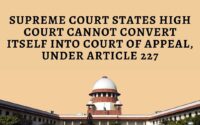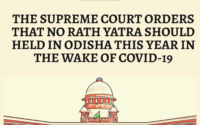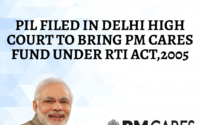Delhi High Court makes serious observations on “The procedural fallibility & shortcomings of GST System
Delhi High Court makes serious observations on “The procedural fallibility & shortcomings of GST System
-VIJPREET PAL
The Delhi High Court made serious observations stating that the case demonstrates ‘how the Tax department has miserably fallen the expectation.’
Observations-
The bench of Justice Manmohan and Sanjiv Narula noted that “We have time and again made adverse remarks on the procedural working of the GST system in several decisions. We may just add that we do not derive any pleasure when we make such observations, as comments of the Court affect the reputation of the administration in the country. Such remarks are made only when we are constrained to do so. The case before us is one where there is a complete lack of understanding and fairness on the part of the Tax Department. The fact that Respondents have done nothing to solve the problem faced by the Petitioner, fueled with the adamant stand before us, contributes to the skepticism of GST technical infrastructure, which we feel should and can be easily avoided. Only if Respondents were to engage with the taxpayers with a genuine intention to solve the problems, confidence in the system can be built up and such matters would not reach courts.”
Since GST law is major tax reform in indirect taxation, the difficulties faced in the filing of the statutory forms are understandable. In this process, human errors cannot be ruled out and if they occur, the solution is not to criticize the taxpayer for the fault, but instead, the Government should endeavor to find a resolution, they further noted.
The bench proceeded to state “We cannot ignore the fact that the necessary Forms under GST are difficult to identify and the Government had to put efforts to assist the citizens in understanding the procedures. To date, GST awareness campaigns and citizen outreach programs are in place to acquaint the taxpayers with the GST filing procedures. Particularly, with the entire system being online, the interface between the taxpayers and authorities is entirely electronic. This requires some basic fundamental knowledge for using the technology.”
The court continued to observe that Instead of offering a restitutive solution they have stonewalled all the attempts made by the Petitioner. The injustice and prejudice caused to the Petitioner are profound and its disillusionment and despair are evident.
In order to overcome the resistance to change and encourage transformation and remodeling of the entire accounting structure at taxpayers’ end, the electronic mode should be user friendly.
Tax laws, as it is, are complex and hard to interpret. Moreover, no matter how well conversant the taxpayers maybe with the tax provisions, errors are bound to occur. Therefore, if the tax filing procedures do not provide for an appropriate avenue to correct a bonafide mistake, the same would lead to the taxpayers avoiding compliances.
The court opined that The government should support its citizens by making the burden of compliance and payment as simple as possible. The intent and efforts of the Government should be to extend proper assistance, information, and education to taxpayers so that they fulfil their obligations. This should be the critical area of focus in the area of tax administration which would ensure compliance with tax laws and also build confidence amongst taxpayers.
Indeed, by explaining the significance of payment of taxes, and the role that a taxpayer plays in building the nation, the Government endeavors to encourage and motivate the citizens to be tax compliant. If we strive to achieve this goal, it is necessary that we must also provide appropriate channels for resolution of their genuine problems. A successful resolution, a positive response, and an effective, timebound redressal mechanism is crucial for building confidence amongst the taxpayers and for successful tax administration.
Factual background-
The petitioner asserts that it is entitled to transitional credit of Rs. 6,52,58,081/- comprising of Central Excise Cenvat credit of Rs. 3,86,54,605/-, Service Tax Cenvat credit of Rs. l,64,79,081/- and Input MVAT credit of Rs. l,01,24,382/. In order to avail the credit in the electronic credit ledger under the GST laws, on 27th August, 2017, much before the last date specified by the Central Government, the Petitioner filed a Form prescribed for this purpose, known as „GST TRAN-l‟. However, on submission of the said Form, Petitioner realized that as against the total credit of Rs. 6,52,58,081/-, only Rs. l,01,24,382/- was reflected on the common GST portal. The CENVAT credit of Rs. 5,51,33,6991/- comprising of Central Excise and Service Tax of Rs.3,86,54,605/- and Rs.1,64,79,0811/- respectively was not displayed in the electronic credit ledger.
When we make a comparison of the figures reflected in the screenshot with those in the statutory returns, it is revealed that the credit which was reflected in Form 231 under the Maharashtra VAT Act of Rs. 10,124,382/- instead of being added to the remaining amount reflected in the tax returns under the Excise Act (ER-1) and Service Tax Act (ST-3), it was instead erroneously reflected under the heading “CENVAT Credit admissible as ITC”. Thus, for this clerical mistake, there has been a short transitioning of the credit, as a result whereof, Petitioner stands to lose a huge amount of ITC, totaling to Rs. 5,51,33,699/- that stood vested in its favor under the erstwhile regime.
In the said case, the Court also held that Rule 117 of the GST Rules is a directory in nature in so far as it prescribes the time limit for transitioning of credit and it cannot result in forfeiture of rights of taxpayers if the same is not availed within the period prescribed therein. Accordingly, this Court allowed taxpayers to avail of the input tax credit by permitting them to file TRAN-1 form on or before 30th June 2020. Learned counsel for the petitioner further submitted that irrespective of the said decision, since admittedly the TRAN-1 form in the case of the Petitioner was filed well before the specified date, notwithstanding the benefit granted by the Court in the said judgment, the Petitioner is entitled to transition the credit. Mr. Harpreet Singh, Senior Standing Counsel for GST on the other hand opposed the petition and submitted that the Petitioner is not entitled to the benefit being sought in the present petition. Mr. Harpreet Singh argued that the Petitioner can also not avail the benefit of the judgment of this Court in the case of Brand EquityTreaties Ltd. (supra), as recently, with the passing of the Finance (Amendment) Act, 2020 which has been given presidential assent on 27th March, 2020, Section 140 of the CGST Act has been retrospectively amended. He submits that vide Section 128 of the Finance (Amendment) Act, 2020, the words “within such time” have been inserted in Section 140 (1) and this amendment has been given retrospective effect from 1st July, 2017. Thus, the Central Government has been granted the power to prescribe the time limit for filing TRAN-1. The absence of power to prescribe a time limit for filing TRAN-1 was a critical factor that weighed with this Court in the case of Brand Equity Treaties (supra) to hold that the limitation period under Rule 117 for filing TRAN-1 is merely directory and not mandatory. But, by virtue of the retrospective amendment, there has been a change in circumstances and the benefit of the judgment in the case of Brand Equity (supra) is no longer available to the Petitioner.
The stand of the Respondent, in a nutshell, is that since Petitioner has committed this mistake, it ought to suffer for the same. Let us assume that indeed the mistake happened purely on account of a human error, for which Petitioner alone is worthy of blame. Does it mean that for this blunder, the law will provide no restitution and it is a fait accompli for the Petitioner? In our view, that should never be the case and law should provide for a remedial avenue. In our view, the stand of the Central Government, focusing on condemning the Petitioner for the clerical mistake and not redressing the grievance, is unsavory and censurable.
In effect, the ITC has been expropriated without any lawful sanctions. The ITC that was shown in the returns under the existing laws were taxes that stood paid to the respective Governments for goods or services were available for adjustment or utilization in accordance with the law. Now, on account of a clerical mistake, the said taxes paid are being appropriated, without cause, putting the Petitioner in serious jeopardy by subjecting it to further taxation under GST without the benefit of ITC. The case before us demonstrates how the tax department has miserably fallen short of the expectation. It is regrettable that Respondents have failed to address the basic and fundamental problem faced by the Petitioner that occurred while filing a Form, seemingly on account of a bona fide or inadvertent mistake. Instead of offering a restitutive solution, they have stonewalled all the attempts made by the Petitioner. The injustice and prejudice caused to the Petitioner are profound and its disillusionment and despair is evident.


